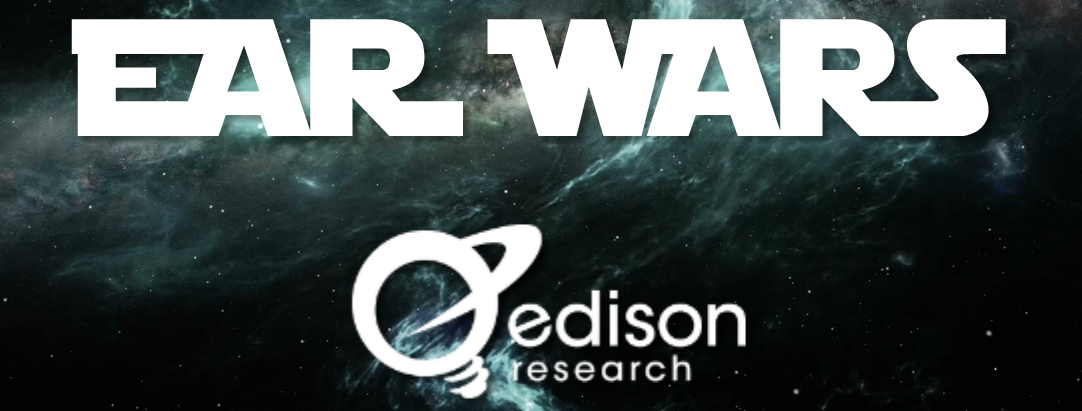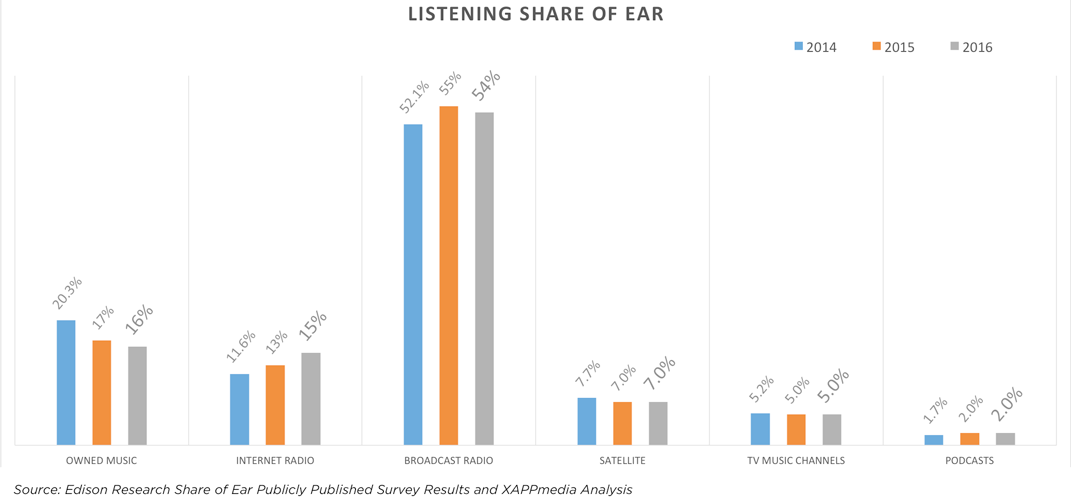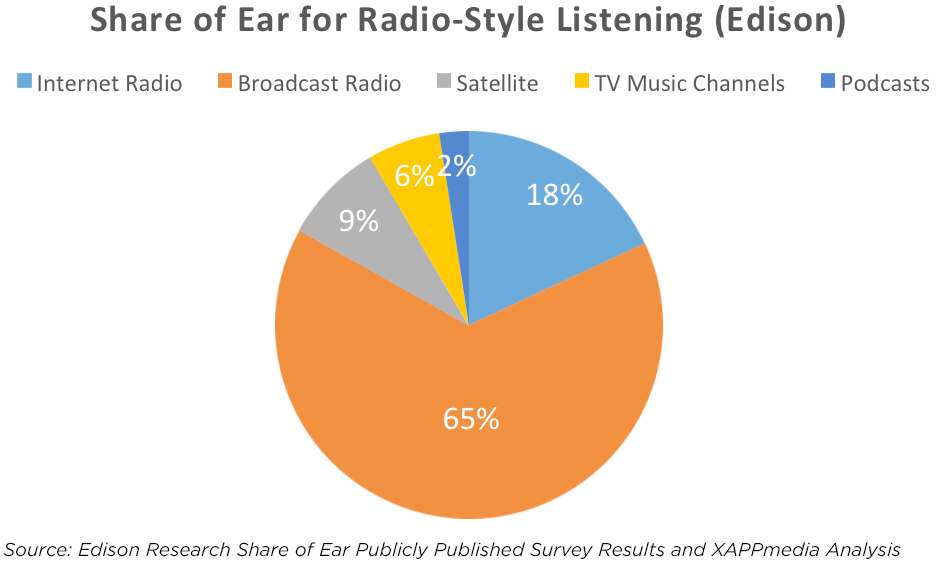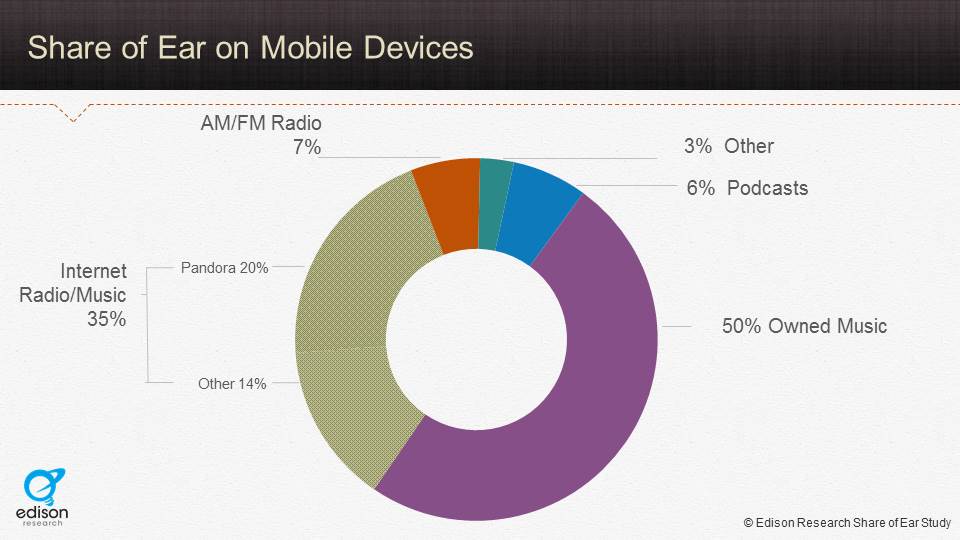Larry Rosin and Megan Lazovick of Edison Research presented new data about broadcast radio and other audio listeners in Nashville last week at the Country Music Seminar. Whereas Edison routinely offers data without recommendations, this presentation was different. The conclusions include recommended strategies and line up around a core set of differentiators that offer broadcasters a competitive edge in an increasingly crowded audio landscape. You can see an intergalactic slide show summary here complete with embedded video interviews. It is an impressive piece of work.

The presentation also has a subtle message that many broadcasters are likely to miss. The real value of a radio station is not the transmission signal. It is the programming and personalities tied to the local community that continues to set radio apart. XAPP has been working closely with radio stations over the past year through our collaboration with jacapps for the JAX solution. jacapps has helped more than 300 radio stations reach fans through dedicated mobile apps and XAPP Ads help those broadcasters monetize their audiences with higher ad rates driven by mobile conversion results that are routinely 20-30 times higher than other mobile ad formats.
Radio’s Differentiated Assets
As we said recently in blogs and media interviews, radio can leverage its programming expertise and local connections to maintain and extend audiences as they shift to mobile. However, this requires a shift in perspective from tangible assets such as the broadcast licenses and equipment to intangibles based on knowledge and creativity. Broadcaster revenue is flat in nominal terms and declining in real terms because it is not even matching inflation. Digital channels in general, and mobile in particular, represent an opportunity to capture advertising revenue in a rapidly growing market.
In the end, transmission over the air is simply distribution which is becoming commoditized. You can receive audio through terrestrial radio waves, satellite, cable television and the Internet. The distribution is largely undifferentiated with one exception. Mobile phones are always with listeners and as a result provide unmatched convenience for accessing audio content. They also provide an opportunity for interactivity not available on other channels. Providing radio content on mobile aligns with changing consumer preferences and the Edison presentation highlights that radio has some advantages to exploit that can reverse audience time-spent-listening erosion. Additional data from Edison helps tell this story in numbers.
The Battle for Listening Time
 The data is clear that consumer behavior is changing and increasing listening time to audio content through mobile phones. eMarketer data show that while radio listening time has declined by 7.4% over the past five years, Internet radio consumption has risen dramatically. Edison’s own Q2 2015 Share of Ear study highlights that generational demographics are leading the shift away from broadcast time spent listening to streaming audio.
The data is clear that consumer behavior is changing and increasing listening time to audio content through mobile phones. eMarketer data show that while radio listening time has declined by 7.4% over the past five years, Internet radio consumption has risen dramatically. Edison’s own Q2 2015 Share of Ear study highlights that generational demographics are leading the shift away from broadcast time spent listening to streaming audio.
Given that 13-34 year-olds now represents the largest U.S. age group as well as the most desirable advertising demographic and the 55+ cohort will soon be contracting; it is an important finding that as much as 35% of millennial “radio” time is now on streaming despite the fact that it may represent only 18% of overall listening. Other Edison data shows the overall trend clearly.

 You can see that Share of Ear data reflects relatively flat usage of broadcast radio (within the survey margin of error), but Internet radio / streaming audio grew 29% between 2013-2015. Streaming audio has picked up nearly all of the time spent listening decline of owned music and satellite radio. This data, in part, confirms the shift from “owned music” to “rented music” consumption characterized by numerous predictions and a recent Throwback Thursday column in RAIN News. Breaking down “radio-style” listening further you see that radio accounts for 65% of time spent listening compared to 18% for Internet radio in 2015.
You can see that Share of Ear data reflects relatively flat usage of broadcast radio (within the survey margin of error), but Internet radio / streaming audio grew 29% between 2013-2015. Streaming audio has picked up nearly all of the time spent listening decline of owned music and satellite radio. This data, in part, confirms the shift from “owned music” to “rented music” consumption characterized by numerous predictions and a recent Throwback Thursday column in RAIN News. Breaking down “radio-style” listening further you see that radio accounts for 65% of time spent listening compared to 18% for Internet radio in 2015.
These findings also confirm that broadcast is still a big distribution channel, but all of the growth is online – a distribution channel where radio broadcasters can compete if they choose.
The New Battleground – Mobile Listening Time
 The shift to mobile audio listening is a big driver of this change. Edison survey results from 2015 show that on mobile, Internet-only audio is chosen five times more frequently than AM/FM broadcast options.
The shift to mobile audio listening is a big driver of this change. Edison survey results from 2015 show that on mobile, Internet-only audio is chosen five times more frequently than AM/FM broadcast options.
Broadcast AM/FM radio represents only 7% of listening time on mobile. There is an argument that Internet radio is simply displacing owned music consumption, but it is also changing consumer habits. Broadcast radio needs to compete on mobile and its current poor showing is, in part, the result of a lack of effort. Few radio broadcasters actually make streaming a priority. However, when you look at demographic trends, shifting listening behavior to mobile and the increasing availability of mobile connectivity in automobiles, it is a critical audience touch point for every audio provider.
The Broadcaster Recipe for Mobile
Edison Research deserves great credit for capturing the data that show why broadcasters should have robust mobile distribution capabilities and how they can differentiate to succeed in an increasingly competitive audio landscape. Leveraging the local connections, personality and timeliness of radio can create a fear of missing out (#FOMO) that will keep listeners engaged and coming back. Edison survey data and focus group findings make a compelling case. Solutions like JAX from XAPPmedia and jacapps can help provide mobile app distribution and monetization to support this strategy.
XAPPmedia laid out five Steps for Broadcasters in a December blog post that included recommendations about delivering interactivity to mobile app audiences and leveraging cross-channel promotion. We will add here for emphasis that the strategies from Edison Research can also be effectively executed through both live streaming and on-demand access. Offering segments of a the best broadcast content for on-demand listening can help boost total listenership and satisfy audience FOMO desire even when they miss the original broadcast. It is a way to extract value from the best content after initial transmission.
To learn more about using XAPPmedia and JAX for your mobile strategy, fill out the form by clicking here.
[su_button style=”flat” size=”6″ background=”#D73C90″ radius=”0″ url=”https://go.pardot.com/emailPreference/e/35552/300″ target=”_blank”]Subscribe to XAPP Blog[/su_button]
Related Posts
4 Charts Show Radio’s Future is on Mobile
Adotas Q&A with Pat Higbie on Digital Marketing for Radio Industry
The Future is Now: Radio World Interviews Pat Higbie on Industry Changes in 2016
